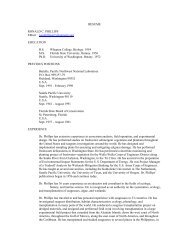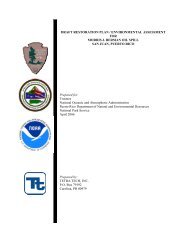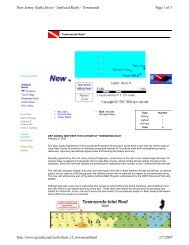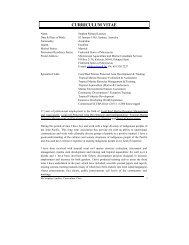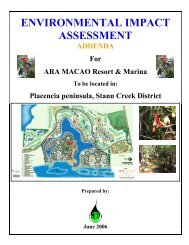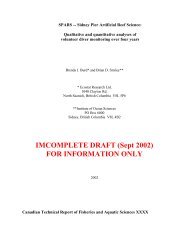Coral reef metrics and habitat equivalency analysis - Reef Ball ...
Coral reef metrics and habitat equivalency analysis - Reef Ball ...
Coral reef metrics and habitat equivalency analysis - Reef Ball ...
Create successful ePaper yourself
Turn your PDF publications into a flip-book with our unique Google optimized e-Paper software.
ARTICLE IN PRESSS. Viehman et al. / Ocean & Coastal Management xxx (2009) 1–8 3accompanied by restoration of all other ecosystem services. Inessence, a proxy is selected to represent the full suite of ecosystemservices, <strong>and</strong> serves as the measure of restoration success. Forexample, in the Florida Keys National Marine Sanctuary, seagrassHEAs use aboveground seagrass biomass as the common <strong>metrics</strong>ince this measure is highly correlated with services provided bythe <strong>habitat</strong> [45]. However, the assumption of a representativemetric is challenging in complex ecosystems [47], <strong>and</strong> thesuccessful application of a metric in seagrass ecosystems requiredextensive supporting research to allow selection of a simplerepresentative. <strong>Coral</strong> <strong>reef</strong>s have not yet undergone a similar processwhere <strong>metrics</strong> are parsed for uniform application under HEA <strong>and</strong>are more complex in terms of ecosystem services provided. Servicescan also occur across <strong>habitat</strong> types, so the ecological context ofa coral <strong>reef</strong> within surrounding mangrove, seagrass, soft <strong>and</strong> hardbottom environments, <strong>and</strong> open water <strong>habitat</strong>s could also beconsidered (with accordingly increased complexity). Nonetheless,when a single metric is not applicable across <strong>habitat</strong> or projecttypes, conversion factors may be used to translate measurement ofone component’s services into equivalents of the other component.The applicability of a specific metric depends upon l<strong>and</strong>scapecontext, biophysical context, <strong>and</strong> the capacity of services beingprovided, including ecological scale, type <strong>and</strong> extent of injury <strong>and</strong>defined goals for restoration success [15,42,48]. As with anyecosystem, there may be no single universal metric applicable to allcoral <strong>reef</strong> NRDA situations, in part because a metric must filla variety of roles, yet it may be feasible to capture a sufficient suiteof services in one or two practical <strong>metrics</strong>. Ideally, the NRDA metricwould link the type of information collected during the fielddamage assessment, the approach for defining, quantifying, <strong>and</strong>projecting recovery from the injury, the available options forcompensatory restoration projects appropriate to the injury, <strong>and</strong>recovery monitoring protocols. For HEA purposes, a metric shouldrepresent ecosystem services to address specific recovery goals,provide appropriate <strong>and</strong> meaningful measurements to determinea realistic recovery horizon that is representative of the injured<strong>habitat</strong>, show measurable change over time at the organizationallevel (i.e. organismal, l<strong>and</strong>scape) at which the injury occurred, <strong>and</strong>be quantifiable using repeatable, field-realistic, cost-effectivedamage assessment techniques that allow reliable return assessmentsas well. In addition, a metric should be applicable toa compensatory restoration project as the same type <strong>and</strong> qualityservice, or translatable to another service through peer-reviewed<strong>and</strong> broadly accepted conversion factors. Finally, the metric shouldbe appropriate for monitoring restoration progress with thesensitivity to detect whether mid-course corrections are needed.2. <strong>Coral</strong> <strong>reef</strong> NRDA <strong>metrics</strong>Most HEA applications in coral <strong>reef</strong> environments have historicallyused one of several <strong>metrics</strong>. In this section, we examine these<strong>metrics</strong> for the robustness, flexibility, <strong>and</strong> application within HEA topredict complex <strong>and</strong> compound (larger scale) results from theoriginal injury. Improving coral <strong>reef</strong> NRDA practice will likelyrequire trustees to move beyond the relatively simple <strong>metrics</strong> thathave historically been used toward a more holistic system of<strong>metrics</strong> that may more accurately reflect the complexity of coral<strong>reef</strong> ecosystems. We do not imply that historical applications havebeen in error, but rather suggest possible directions for futurediscussion <strong>and</strong> refinements.2.1. Single, total coral cover metricFor coral <strong>reef</strong> grounding injuries in the U.S., NRDAs have traditionallyused a two-dimensional measurement of all biologicalcoral tissue cover measured as either area or percent cover [17]. Theconceptual basis is that an increase in total coral cover requiressuccessful recruitment <strong>and</strong> growth, <strong>and</strong> will promote <strong>reef</strong> structuralcomplexity <strong>and</strong> ecosystem richness [17]. The advantage ofa coral cover metric in the NRDA process is that the service flow isintuitive; the amount of total coral cover injured requires thata similar amount of coral cover be restored. Field measurements ofbenthic cover for the initial injury assessment <strong>and</strong> recoverymonitoring can be relatively straightforward [49,50] (although lessso for branching corals). In addition, coral cover has been a commonparameter in <strong>reef</strong> monitoring publications for the past severaldecades, so l<strong>and</strong>scape-scale historical data may exist for a particular<strong>reef</strong>. From an economic perspective, a coral cover metric isa transparent application of the HEA equation: the amount of coralcover inside the injury is expressed as a percentage of coral cover ina reference area (selected to represent the baseline condition of theinjured area), <strong>and</strong> this proportion is projected over a time to estimatecoral cover recovery. With a single coral cover metric thattreats all coral species equally, no weighting factors are requiredwithin the HEA to equate for different levels of service contributionsby different coral species. A coral cover metric is easilytranslatable to compensatory restoration projects such as transplantation,coral nurseries, <strong>and</strong> recruitment seeding that aredesigned to increase coral cover. Therefore, ecological serviceconversion factors for compensatory restoration options are notrequired to account for a compensatory restoration that differsfrom the injury metric.From an ecological perspective, however, a coral cover metricmay be an overly simplistic representative of ecosystem services.A coral cover metric requires the assumption that scleractiniancoral cover is correlated with other services provided by a coral <strong>reef</strong>(such as those provided by non-scleractinian sessile benthicinvertebrates, mobile invertebrates, vertebrate herbivores <strong>and</strong>carnivores, algae, <strong>and</strong> the nonliving <strong>reef</strong> framework itself). Whilethis assumption may be supportable for certain types of injuries or<strong>reef</strong>s, for others, particularly those with low pre-injury scleractiniancoral cover, ecosystem services may be more influenced byother benthic organisms such as sponges, octocorals, or algae. Inthese <strong>habitat</strong>s, other taxa may recover more or less quickly thanscleractinian corals, <strong>and</strong> the restoration requirement may be biasedif hard coral cover is the only metric used.A coral cover metric also does not address variations inecosystem services provided by different coral species or functionalgroups (e.g. diversity, composition, colony size, morphology,potential accretion rate, level <strong>and</strong> type of <strong>habitat</strong> provided) norwhether services scale with size or age (e.g. reproduction). An HEArecovery estimate for a coral cover metric may be based on recoveryof total coral cover or on attributes of selected species, such as fora species-oriented recovery model [51]. With a species-orientedapproach, the selected species needs to have estimated growthrates, morphology <strong>and</strong> other species attributes appropriate to thecontext of the injury <strong>and</strong> the <strong>reef</strong>, for these will affect recoveryprojections <strong>and</strong> restoration planning. A coral cover metric thereforehas the potential to over- or under-represent the contributions ofselected species attributes. This could become complicated withinan NRDA framework if a species listed as threatened or endangeredunder the U.S. Endangered Species Act (such as Caribbean acroporids)is involved, but is not a dominant species at the injury site.The limitations inherent with a metric of two-dimensional areaof total living scleractinian coral tissue imply that this <strong>metrics</strong>hould be limited to specific types of injuries or types of coral <strong>reef</strong>communities rather than broadly applied to all injuries. A coralcover metric could be appropriate for an injury that does notdirectly address structural complexity, such as an abrasion or othertissue injury to a coral colony, or an injury to a hard bottom orPlease cite this article in press as: Viehman S et al., <strong>Coral</strong> <strong>reef</strong> <strong>metrics</strong> <strong>and</strong> <strong>habitat</strong> <strong>equivalency</strong> <strong>analysis</strong>, Ocean & Coastal Management (2009),doi:10.1016/j.ocecoaman.2008.12.004
ARTICLE IN PRESSS. Viehman et al. / Ocean & Coastal Management xxx (2009) 1–8 5size-frequency distribution also has inherent challenges for scalingto compensatory restoration. Rather than estimating the primaryrecovery <strong>and</strong> compensatory restoration benefits for a single species,this method requires calculating those parameters for multiple sizeclasses within multiple scleractinian species (or genera or functionalgroups) <strong>and</strong> for organisms other than scleractinian corals.Size-frequency information can be more difficult than coral cover touse in an HEA or REA which requires an estimate of recovery time<strong>and</strong> the shape of the recovery curve. Comparison of size-frequencydistributions via goodness-of-fit tests at each time step allows anestimate of how long it takes for the populations to converge [67]but the statistics can only discern whether or not the populationsare the same, <strong>and</strong> provide little information on the shape of therecovery curve, a critical parameter in HEA <strong>and</strong> REA. Alternatively,recovery projections could be modeled for each size categorywithin each coral species/genera/group <strong>and</strong> then combined acrosseach species/genera/group. Despite its advantage in capturinga greater suite of services by multiple community components, thisapproach may require ecological service conversion factorsbetween size classes of a single species <strong>and</strong> between differentspecies to fit with available compensatory restoration options. Lackof objective <strong>and</strong> quantitative methods to develop these REAconversion factors is a substantial obstacle to broad implementationof this approach. However, current coral cover <strong>and</strong> composite<strong>metrics</strong> HEA approaches also face identical challenges (see above).For NRDAs in non-coral <strong>reef</strong> environments, scaling to compensatoryrestoration has been addressed using a <strong>habitat</strong>-basedreplacement cost (HRC) approach which combines the HEA <strong>and</strong>REA concepts [71,72]. In this method, losses are first quantifiedusing an REA. Next, suitable restoration options are identified toaddress <strong>habitat</strong> limitations for each impacted species group,prioritized by quantification of benefits, <strong>and</strong> selected for eachimpacted species. Finally, restoration options are scaled so thatincreases in production as a result of restoration options wouldoffset losses for each impacted species group [71]. In oil spillNRDAs, common examples of this approach include compensatingfor bird, fish, or shellfish losses with creation of marshes to providenesting, nursery <strong>and</strong> foraging <strong>habitat</strong> [73,74]. The HRC approachmay be appropriate for coral <strong>reef</strong> REAs; however, it does assume<strong>habitat</strong> is the limiting factor for local production of replacementorganisms. For certain coral <strong>reef</strong>s <strong>and</strong> coral <strong>reef</strong> injuries, coralrecruitment may be the limiting factor rather than available <strong>and</strong>appropriate <strong>habitat</strong>, which would pose problems in developingcomparative recovery functions.An intensive REA approach is likely best suited for comparativelylarge incidents in complex settings. For large incidents, thepotential increase in precision afforded by the REA approach maylead to an increased level of confidence that the calculated restorationrequirement is sufficient to fully offset the losses due toinjury. For smaller incidents or those that occur in areas that haverelatively little species diversity, the common NRDA method ofusing a single representative metric <strong>and</strong> HEA may be sufficient.2.4. Topographic complexityOne of the criticisms of two-dimensional <strong>metrics</strong> such as coralcover or size-frequency distribution is that none adequatelycapture a reduction in the complex three-dimensional <strong>reef</strong>topology. A reduction, restructuring, or destabilization of topographiccomplexity (e.g. pulverized <strong>reef</strong> spur) can limit coralrecruitment <strong>and</strong> recovery [5,75], can shift the recovering communitycomposition [76,77], can increase vulnerability to stormdamage [75], <strong>and</strong> can influence <strong>reef</strong> hydrodynamics which couldlead to an expansion of the original injury. Although injuries to thephysical <strong>reef</strong> structure are frequently measured in damageassessments, it has not traditionally been included within HEAequation itself. Instead, <strong>reef</strong> framework injury has been includedwithin the NRDA process as an ancillary service, a service integral tothe natural resource at the l<strong>and</strong>scape scale [10]. As such, it influencesthe criteria for determining compensatory restorationoptions appropriate to the injury. Within a suite of compensatoryrestoration options identified for a <strong>reef</strong> injury involving structuralcomplexity, those that restore any physical structure have beenconsidered more favorable to implement than those not restoringstructure. This approach does not include relating the quantity ofcomplexity lost to what will be replaced.Services associated with a complex, three-dimensional structureof the <strong>reef</strong> could be captured with a metric <strong>and</strong> included in theHEA equation. While there are many instances, particularly inFlorida <strong>and</strong> the Caribbean, when topographic complexity would beunlikely to recover naturally in the limited HEA-relevant timeframe of 70–100 years <strong>and</strong> should be considered an injury inperpetuity for HEA purposes, this assumption will not be appropriatefor relatively fast-growing coral species. Monitoring frameworkstructure is intended to evaluate whether the structure ispresent <strong>and</strong> intact, <strong>and</strong>, if coupled with a biological metric (coralcover or size-frequency), can evaluate the ecological contributionsof the framework to the system. A topographic complexity metrichas a straightforward translation to compensatory restorationprojects. Specific approaches to accelerate <strong>habitat</strong> restoration using<strong>reef</strong> engineering techniques have varied widely <strong>and</strong> have includedspur rebuilding, modules, <strong>and</strong> <strong>reef</strong> crowns [16]. The design <strong>and</strong>composition of the engineered structure, however, will affect itspotential for successful coral recruitment [54,77] <strong>and</strong> growth,important factors to be considered to ensure coral growth on anyengineered structure so granting credit for restoration of frameworkstructure may become a secondary benefit in the case of aninjury in an area of limited or declining recruitment. Therefore,incorporating a topographic complexity metric with a cover metricremains an unresolved challenge for further research in coral <strong>reef</strong>restoration.3. <strong>Coral</strong> <strong>reef</strong> NRDAs: unstable baselines <strong>and</strong> multiple stablestates3.1. BaselinesIn NRDA recovery projections, the baseline projection is generallyassumed to be static (Fig. 2) [26]. In essence, this means theResource servicesservice lossBaseline service levelTimeFig. 2. Changing baseline service levels of the injured <strong>reef</strong> <strong>and</strong> uninjured referencepopulations may need to be considered when recovery trajectories are projected. Asteady decline may be modeled (b) or, data may show a variable decline over time (c).abcPlease cite this article in press as: Viehman S et al., <strong>Coral</strong> <strong>reef</strong> <strong>metrics</strong> <strong>and</strong> <strong>habitat</strong> <strong>equivalency</strong> <strong>analysis</strong>, Ocean & Coastal Management (2009),doi:10.1016/j.ocecoaman.2008.12.004
ARTICLE IN PRESS6S. Viehman et al. / Ocean & Coastal Management xxx (2009) 1–8baseline, the condition that would exist but for the injury, isconsidered equivalent to the pre-injury condition throughout theHEA time frame. Within the HEA recovery projections, this does notallow for a shifting baseline caused by changes in the condition ofthe reference community (Fig. 2). In an NRDA context, if the baselineis not strictly re-established, different services will be providedinstead. In most cases, a static baseline for recovery projections isnecessitated by a lack of adequate data. However, one approach todetermine when the recovery projection meets the baselineprojection could be to model a reference community simultaneouslywith the injured community [67] <strong>and</strong> re-adjust therecovery scenario periodically (although this has severe practicallimitations in a legal case). This type of simultaneous recoverymodeling further requires the assumption that the populationdynamics are equivalent in the injured <strong>and</strong> uninjured areas.3.2. Multiple stable statesAfter a disturbance such as a vessel grounding, a coral <strong>reef</strong> mayrecover temporarily or permanently to an alternate state ratherthan via classical succession to the pre-injury condition [78–81]. Insuch a situation, the coral species or community structure lost dueto the injury would not be equivalent to what actually comes back(Fig. 3). Unrestored framework injury can contribute to the developmentof a community far different from that of the pre-injurycommunity, such as in the case of the M/V Wellwood in the FloridaKeys, in which recovery of a pulverized spur <strong>and</strong> groove <strong>reef</strong>stabilized in a low-relief hard bottom state until engineeredstructure was added [82]. Similarly, a coral-dominated <strong>reef</strong> couldbecome an algal dominated <strong>reef</strong> [79], or recovering communitiesmay be composed of different coral species which may providedifferent services. For example, the limited natural coral recruitmentinto injuries in the Florida Keys <strong>and</strong> the Caribbean is dominatedby brooding coral species, such as P. astreoides, with weedygrowth characteristics (rapid growth, limited accretion rate, relativelyshort lifespan) rather than framework-building corals thathave slower growth but more potential to provide structural<strong>habitat</strong> over a longer time [53,77,83–85]. Complete recovery to thebaseline condition (if possible) may simply be outside of the HEArelevanttime frame. Alternate stable states may be addressed in theHEA either as a loss in perpetuity or through conversion factors totranslate the ecological services provided by the new communityinto quantifiable units of the original communities. These conversionfactors would ideally be based on objective measurements ofthe services provided by both the original <strong>and</strong> re-established coralcommunities. In practice, however, such conversion factors areoften predicated on expert opinion due to lack of available data.4. Conclusions<strong>Coral</strong> <strong>reef</strong> restoration is very much a developing science. Few, ifany, injuries have been followed from impact to complete recoveryas part of the NRDA process. Consequently, expert estimates aboutwhether a site will recover in 30, 50, 300 years, or not at all, arenecessarily imperfect [17], but bear the responsibility of being thebest available information at present. Almost all of the approachesdetailed in our review rely heavily on expert opinion, which isunlikely to be determined in a universally accepted manner,contributing to the adversarial nature of determining the extent<strong>and</strong> cost of restoration. Thus, this review is also an encouragementfor coral <strong>reef</strong> NRDAs to become a process that supports the developmentof objective (quantitative) rather than the current, oftensubjective process. As more informative data emerge from research,restoration monitoring, <strong>and</strong> HEA applications, they should beapplied to advance the NRDA process in conjunction with coral <strong>reef</strong>restoration science.In its simplest form, the objective of coral <strong>reef</strong> restoration conductedthrough the NRDA process is to restore the services lostfrom the injuries caused by the responsible party. It is often difficultto know whether the trustee actions are sufficient to reach thisobjective given the current state of <strong>reef</strong> restoration science <strong>and</strong>NRDA practice. While the practical <strong>and</strong> measurable goals of restorationare to rapidly re-create the structure <strong>and</strong> functions of aninjury <strong>habitat</strong>, the approaches for realizing this goal are continuallyevolving. There is a delicate balance between broad, general operatingprinciples <strong>and</strong> site specificity. Careful selection of the theoreticalNRDA approach (HEA-based using two-dimensional coralcover or composite <strong>metrics</strong>, or REA-based using size-frequencydistributions) <strong>and</strong> <strong>metrics</strong> appropriate to both the degree <strong>and</strong>extent of injury <strong>and</strong> of <strong>habitat</strong> type will serve as a vital link betweenthe damage assessment, recovery modeling, compensatory calculations,<strong>and</strong> recovery monitoring. An immense amount of informationis necessary to fully underst<strong>and</strong> the type <strong>and</strong> magnitude ofecological services provided by the injured coral <strong>reef</strong> in its baselinecondition, the manner in which those ecological services willrecover following the injury, <strong>and</strong> the relationship of those serviceswith those provided via compensatory restoration projects. Ourchallenge is to capture this information in broadly accepted <strong>metrics</strong>that are cost-effective to obtain. However, more complete underst<strong>and</strong>ingof coral <strong>reef</strong> ecological services is required to objectivelydetermine whether selected compensatory restoration projectsadequately restore lost services for a given injury.Baseline service level<strong>reef</strong>AcknowledgmentsResource servicesservice losshardbottommacroalgaes<strong>and</strong>We thank K. Barry, C. Beaver, C.J. Beegle-Krause, J. Cubit,S. Donahue, B. Goodwin, M. Fonseca, W. Jaap, J. Schittone, <strong>and</strong>S. Shutler for helpful discussion during a 2005 working group.Thanks to T. Penn, K. Pease, J. Schittone, <strong>and</strong> especially to MarkFonseca for extensive comments which have improved the manuscript.S.T. was supported by NOAA’s Office of Response <strong>and</strong>Restoration during manuscript development. The opinions arethose of the authors, who are solely responsible for the content.TimeReferencesFig. 3. An injured <strong>reef</strong> may not recover to its initial state, but may instead recover to analternative state that will not provide the type or level of ecosystem services that were lost.[1] Schmahl GP, Deis DR, Shutler SK. Cooperative natural resource damageassessment <strong>and</strong> coral <strong>reef</strong> restoration at the container ship Houston groundingPlease cite this article in press as: Viehman S et al., <strong>Coral</strong> <strong>reef</strong> <strong>metrics</strong> <strong>and</strong> <strong>habitat</strong> <strong>equivalency</strong> <strong>analysis</strong>, Ocean & Coastal Management (2009),doi:10.1016/j.ocecoaman.2008.12.004
ARTICLE IN PRESSS. Viehman et al. / Ocean & Coastal Management xxx (2009) 1–8 7in the Florida Keys National Marine Sanctuary. In: Precht WF, editor. <strong>Coral</strong> <strong>reef</strong>restoration h<strong>and</strong>book. Boca Raton, Florida: CRC Press; 2006. p. 235–56.[2] Bruckner AW, Bruckner RJ. Restoration outcomes of the Fortuna <strong>Reef</strong>ergrounding at Mona isl<strong>and</strong>, Puerto Rico. In: Precht WF, editor. <strong>Coral</strong> <strong>reef</strong>restoration h<strong>and</strong>book. Boca Raton, Florida: CRC Press; 2006. p. 257–69.[3] Hudson JH, Diaz R. Damage survey <strong>and</strong> restoration of M/V Wellwoodgrounding site, Molasses <strong>Reef</strong>, Key Largo National Marine Sanctuary, Florida.Proceedings of the Sixth International <strong>Coral</strong> <strong>Reef</strong> Symposium, Australia, vol. 2;1988. p. 231–6.[4] Jaap WC. <strong>Coral</strong> <strong>reef</strong> restoration. Ecological Engineering 2000;15(3–4):345–64.[5] Rogers CS, Garrison VH. Ten years after the crime: lasting effects of damagefrom a cruise ship anchor on a coral <strong>reef</strong> in St. John, U.S. Virgin Isl<strong>and</strong>s. Bulletinof Marine Science 2001;69(2):793–803.[6] National Oceanic <strong>and</strong> Atmospheric Administration, Office of Response <strong>and</strong>Restoration. Oil spills in coral <strong>reef</strong>s. Planning <strong>and</strong> response considerations.Silver Spring, Maryl<strong>and</strong>: National Oceanic <strong>and</strong> Atmospheric Administration;2001.[7] Jokiel PL, Kolinski SP, Naughton J, Maragos JE. Review of coral <strong>reef</strong> restoration<strong>and</strong> mitigation in Hawaii <strong>and</strong> the U.S.-affiliated Pacific isl<strong>and</strong>s. In: Precht WF,editor. <strong>Coral</strong> <strong>reef</strong> restoration h<strong>and</strong>book. Boca Raton, Florida: CRC Press; 2006.p. 271–90.[8] Tetra Tech EC Inc. Maritime Industry <strong>and</strong> Coastal Construction ImpactsWorkshop. Dania Beach, Florida: Southeast Florida <strong>Coral</strong> <strong>Reef</strong> Initiative,Maritime Industry <strong>and</strong> Coastal Construction Impacts Focus Team; 2007.[9] National Marine Sanctuaries Act. 1972, 16 U.S.C. x 1443.[10] Oil Pollution Act. 33 U.S.C. 1990, x 2701, et seq.[11] Comprehensive Environmental Response, Compensation, <strong>and</strong> Liability Act.1980, 42 U.S.C. x 9607.[12] National Park Service Resource Protection Act. 1990, 16 U.S.C. x 19jj.[13] Jones CA, Pease KA. Restoration-based compensation measures in naturalresource liability statutes. Contemporary Economic Policy 1997;15(4):111–22.[14] Thayer GW, McTigue TA, Bellmer RJ, Burrows FM, Merkey DH, Nickens AD,et al. Science-based restoration monitoring of coastal <strong>habitat</strong>s. In: A frameworkfor monitoring plans under the Estuaries <strong>and</strong> Clean Waters Act of 2000(Public Law 160-457), vol. 1. NOAA Coastal Ocean Program Decision AnalysisSeries No. 23. Silver Spring, Maryl<strong>and</strong>: NOAA National Centers for CoastalOcean Science; 2003.[15] National Oceanic <strong>and</strong> Atmospheric Administration, Damage Assessment <strong>and</strong>Restoration Program. Habitat <strong>equivalency</strong> <strong>analysis</strong>: an overview. Revised2006. Silver Spring, Maryl<strong>and</strong>: National Oceanic <strong>and</strong> AtmosphericAdministration; 1995.[16] Zimmer B. <strong>Coral</strong> <strong>reef</strong> restoration: an overview. In: Precht WF, editor. <strong>Coral</strong> <strong>reef</strong>restoration h<strong>and</strong>book. Boca Raton, Florida: CRC Press; 2006. p. 39–59.[17] Shutler SK, Gittings S, Penn T, Schittone J. Compensatory restoration: howmuch is enough? Legal, economic, <strong>and</strong> ecological considerations. In:Precht WF, editor. <strong>Coral</strong> <strong>reef</strong> restoration h<strong>and</strong>book. Boca Raton, Florida: CRCPress; 2006. p. 77–93.[18] Bourque A, Clark R, Curry R, Lanzendorf B, Carriero J, Whittington T, et al. AllieB grounding site restoration plan/environmental assessment. Homestead,Florida: National Park Service, U.S. Department of the Interior, BiscayneNational Park; 2007.[19] Bourque A, Whittington T, Lanzendorf B, Carriero J, Tilmant J. Igloo Moongrounding site restoration plan/environmental assessment. Homestead, Florida:U.S. Department of the Interior, National Park Service, Biscayne NationalPark; 2007.[20] Carson D, Vare C. Evaluation of <strong>reef</strong> restoration efforts off Boca Raton, Florida.West Palm Beach, Florida: Palm Beach County Environmental ResourcesManagement; 1993.[21] Government of American Samoa, U.S. Department of the Interior, NationalOceanic <strong>and</strong> Atmospheric Administration. Emergency Restoration Plan <strong>and</strong>Environmental Assessment Pago Pago Harbor American Samoa. Governmentof American Samoa, U.S. Department of the Interior, National Oceanic <strong>and</strong>Atmospheric Administration; 1999.[22] Bentivoglio A. Compensatory mitigation for coral <strong>reef</strong> impacts in the PacificIsl<strong>and</strong>s. Final Report. Honolulu, Hawaii: United States Fish <strong>and</strong> WildlifeService, Pacific Isl<strong>and</strong>s Fish <strong>and</strong> Wildlife Office; 1993.[23] Egoh B, Rouget M, Reyers B, Knight AT, Cowling RM, van Jaarsveld AS, et al.Integrating ecosystem services into conservation assessments: a review.Ecological Economics 2007;63:714–21.[24] Thur SM. Refining the use of <strong>habitat</strong> <strong>equivalency</strong> <strong>analysis</strong>. EnvironmentalManagement 2007;40:161–70.[25] Spieler RE, Gilliam DS, Sherman RL. Artificial substrate <strong>and</strong> coral <strong>reef</strong> restoration:what do we need to know to know what we need? Bulletin of MarineScience 2001;69(2):1013–30.[26] Mazzotta MJ, Opaluch JJ, Grigalunas TA. Natural resource damage assessment:the role of resource restoration. Natural Resource Journal1994;34:153–78.[27] Hatcher BG. <strong>Coral</strong> <strong>reef</strong> ecosystems: how much greater is the whole than thesum of the parts? <strong>Coral</strong> <strong>Reef</strong>s 1997;16:S77–91.[28] Costanza R, d’Arge R, de Groot RS, Farber S, Grasso M, Hannon B, et al. Thevalue of the world’s ecosystem services <strong>and</strong> natural capital. Nature1997;387:253–60.[29] Moberg F, Folke C. Ecological goods <strong>and</strong> services of coral <strong>reef</strong> ecosystems.Ecological Economics 1999;29:215–33.[30] Souter DW, Linden O. The health <strong>and</strong> future of coral <strong>reef</strong> systems. Ocean <strong>and</strong>Coastal Management 2000;43:657–88.[31] Nyström M, Folke C. Spatial resilience of coral <strong>reef</strong>s. Ecosystems 2001;4:406–17.[32] Spurgeon JPG. The economic valuation of coral <strong>reef</strong>s. Marine Pollution Bulletin1992;24(11):529–36.[33] Cesar HSJ, van Beukering PJH. Economic valuation of the coral <strong>reef</strong>s of Hawai’i.Pacific Science 2004;58(2):231–42.[34] Wielgus J, Chadwick-Furman NE, Zeitouni N, Shechter M. Effects of coral <strong>reef</strong>attribute damage on recreational welfare. Marine Resource Economics2003;18:225–37.[35] van Beukering PJH, Cesar HSJ. Ecological economic modeling of coral <strong>reef</strong>s:evaluating tourist overuse at Hanauma Bay <strong>and</strong> algae blooms at the KiheiCoast, Hawai’i. Pacific Science 2004;58(2):243–60.[36] Anderson JEC. The recreational cost of coral bleaching – a stated <strong>and</strong> revealedpreference study of international tourists. Ecological Economics 2007;62:704–15.[37] Br<strong>and</strong>er LM, Van Beukering P, Cesar HSJ. The recreational value of coral <strong>reef</strong>s:a meta-<strong>analysis</strong>. Ecological Economics 2007;63(1):209–18.[38] Ahmed M, Umali GM, Chong CK, Rull MF, Garcia MC. Valuing recreational <strong>and</strong>conservation benefits of coral <strong>reef</strong>s – the case of Bolinao, Philippines. Ocean<strong>and</strong> Coastal Management 2007;50:103–18.[39] Daily GC, Alex<strong>and</strong>er S, Ehrlich PR, Goulder L, Lubchenco J, Matson PA, et al.Ecosystem services: benefits supplied to human societies by natural ecosystems.Issues in Ecology 1997;2:1–16.[40] Ruiz-Jaen MC, Aide TM. Restoration success: how is it being measured?Restoration Ecology 2005;13(3):569–77.[41] Unsworth RE, Bishop RC. Assessing natural resource damages using environmentalannuities. Ecological Economics 1994;11:35–41.[42] Allen II PD, Chapman DJ, Lane D. Scaling environmental restoration to offsetinjury using <strong>habitat</strong> <strong>equivalency</strong> <strong>analysis</strong>. In: Bruins RJF, Heberling MT, editors.Economics <strong>and</strong> ecological risk assessment: applications to watershedmanagement. Boca Raton, Florida: CRC Press; 2005. p. 165–84.[43] Hampton S, Zafonte M. Calculating compensatory restoration in naturalresource damage assessments: recent experience in California. Proceedings ofthe California <strong>and</strong> the World Ocean ’02 Conference: revisiting <strong>and</strong> revisingCalifornia’s ocean agenda. Reston, Virginia; 2005. p. 833–44.[44] Zafonte M, Hampton S. Exploring welfare implications of resource <strong>equivalency</strong><strong>analysis</strong> in natural resource damage assessments. Ecological Economics2007;61:134–45.[45] Fonseca MS, Julius BE, Kenworthy WJ. Integrating biology <strong>and</strong> economics inseagrass restoration: How much is enough <strong>and</strong> why? Ecological Engineering2000;15:227–37.[46] National Oceanic <strong>and</strong> Atmospheric Administration, Damage Assessment <strong>and</strong>Restoration Program. Discounting <strong>and</strong> the treatment of uncertainty in naturalresource damage assessment. Silver Spring, Maryl<strong>and</strong>: National Oceanic <strong>and</strong>Atmospheric Administration; 1999.[47] Dunford RW, Ginn TC, Desvousges WH. The use of <strong>habitat</strong> <strong>equivalency</strong> <strong>analysis</strong>in natural resource damage assessments. Ecological Economics 2004;48:49–70.[48] King DM. Comparing ecosystem services <strong>and</strong> values: with illustrations forperforming <strong>habitat</strong> <strong>equivalency</strong> <strong>analysis</strong>. Damage Assessment <strong>and</strong> RestorationProgram. Silver Spring, Maryl<strong>and</strong>: National Oceanic <strong>and</strong> AtmosphericAdministration; 1997.[49] Banks K, Dodge RE, Fisher L, Stout D, Jaap W. Florida coral <strong>reef</strong> damage fromnuclear submarine grounding <strong>and</strong> proposed restoration. Special issue. Journalof Coastal Research 1998;26:64–71.[50] Hudson JH, Goodwin WB. Assessment of vessel grounding injury to coral <strong>reef</strong><strong>and</strong> seagrass <strong>habitat</strong>s in the Florida Keys National Marine Sanctuary, Florida:protocol <strong>and</strong> methods. Bulletin of Marine Science 2001;69(2):509–16.[51] Piniak GA, Fonseca MS, Kenworthy WJ, Whitfield PE, Fisher G, Julius BE.Applied modeling of coral <strong>reef</strong> ecosystem function <strong>and</strong> recovery. In:Precht WF, editor. <strong>Coral</strong> <strong>reef</strong> restoration h<strong>and</strong>book. Boca Raton, Florida: CRCPress; 2006. p. 95–117.[52] Zengel S, Hinkeldey H. <strong>Coral</strong> <strong>reef</strong> recovery: literature review <strong>and</strong> recommendationsfor damage assessment <strong>and</strong> restoration planning. Silver Spring,Maryl<strong>and</strong>: Research Planning, Inc.; 2001.[53] Miller MW, Weil E, Szmant AM. <strong>Coral</strong> recruitment <strong>and</strong> juvenile mortality asstructuring factors for <strong>reef</strong> benthic communities in Biscayne National Park,USA. <strong>Coral</strong> <strong>Reef</strong>s 2000;19:115–23.[54] Moulding AL. <strong>Coral</strong> recruitment in the Florida Keys: patterns, processes, <strong>and</strong>applications to <strong>reef</strong> restoration. <strong>Coral</strong> Gables, FL: University of Miami; 2007.157pp.[55] Milon JW, Dodge RE. Applying <strong>habitat</strong> <strong>equivalency</strong> <strong>analysis</strong> for coral <strong>reef</strong>damage assessment <strong>and</strong> restoration. Bulletin of Marine Science2001;69(2):975–88.[56] Meesters EH, Hilterman M, Kardinaal E, Keetman M, deVries M, Bak RPM.Colony size-frequency distributions of scleractinian coral populations: spatial<strong>and</strong> interspecific variation. Marine Ecology Progress Series 2001;209:43–54.[57] Vermeij MJA, Bak RPM. Species-specific population structure of closely relatedcoral morphospecies along a depth gradient (5–60 m) over a Caribbean <strong>reef</strong>slope. Bulletin of Marine Science 2003;73(3):725–44.[58] Bak RPM, Meesters EH. <strong>Coral</strong> population structure: the hidden informaiton ofcolony size-frequency distributions. Marine Ecology Progress Series1998;162:301–6.Please cite this article in press as: Viehman S et al., <strong>Coral</strong> <strong>reef</strong> <strong>metrics</strong> <strong>and</strong> <strong>habitat</strong> <strong>equivalency</strong> <strong>analysis</strong>, Ocean & Coastal Management (2009),doi:10.1016/j.ocecoaman.2008.12.004
ARTICLE IN PRESS8S. Viehman et al. / Ocean & Coastal Management xxx (2009) 1–8[59] Mumby PJ, Chisholm JRM, Edwards AJ, Clark CD, Roark EB, Andrefouet S, et al.Unprecedented bleaching-induced mortality in Porites spp. at Rangiroa Atoll,French Polynesia. Marine Biology 2001;139:183–9.[60] Richardson LL, Voss JD. Changes in a coral population on <strong>reef</strong>s of the northernFlorida Keys following a coral disease epizootic. Marine Ecology ProgressSeries 2005;297:147–56.[61] Meesters EH, Wesseling I, Bak RPM. Partial mortality in three species of <strong>reef</strong>buildingcorals <strong>and</strong> the relation with colony morphology. Bulletin of MarineScience 1996;58(3):838–52.[62] Ruesink JL. <strong>Coral</strong> injury <strong>and</strong> recovery: matrix models link process to pattern.Journal of Experimental Marine Biology <strong>and</strong> Ecology 1997;210:187–208.[63] Epstein N, Vermeij MJA, Bak RPM, Rinkevich B. Alleviating impacts ofanthropogenic activities by traditional conservation measures: can a small<strong>reef</strong> reserve be sustainedly managed? Biological Conservation 2005;121:243–55.[64] Beltràn-Torres AU, Muñoz-Sànchez L, Carricart-Ganivet JP. Effects of HurricaneKeith at a patch <strong>reef</strong> on Banco Chinchorro, Mexican Caribbean. Bulletin ofMarine Science 2003;73(1):187–96.[65] Mumby PJ. Bleaching <strong>and</strong> hurricane disturbances to populations of coralrecruits in Belize. Marine Ecology Progress Series 1999;190:27–35.[66] Lewis JB. Abundance, distribution <strong>and</strong> partial mortality of the massive coralSiderastrea siderea on degrading coral <strong>reef</strong>s at Barbados, West Indies. MarinePollution Bulletin 1997;34(8):622–7.[67] Lirman D, Miller MW. Modeling <strong>and</strong> monitoring tools to assess recovery status<strong>and</strong> convergence rates between restored <strong>and</strong> undisturbed coral <strong>reef</strong> <strong>habitat</strong>s.Restoration Ecology 2003;11(4):448–56.[68] Hudson JH, Schittone J, Anderson J, Franklin EC, Stratton A. M/V Alec OwenMaitl<strong>and</strong> coral <strong>reef</strong> restoration monitoring report, monitoring events 2004–2007. Florida Keys National Marine Sanctuary Monroe County, Florida. SilverSpring, MD: U.S. Department of Commerce, National Oceanic <strong>and</strong> AtmosphericAdministration, National Marine Sanctuary Program; 2008.[69] Sperduto MB, Powers SP, Donlan M. Scaling restoration to achieve quantitativeenhancement of loon, seaduck, <strong>and</strong> other seabird populations. Marine EcologyProgress Series 2003;264:221–32.[70] Gittings SR, Bright TJ, Hagman DK. The M/V Wellwood <strong>and</strong> other large vesselgroundings: coral <strong>reef</strong> damage <strong>and</strong> recovery. In: Ginsburg RN, editor. Globalaspects of coral <strong>reef</strong>s. Health, hazards, <strong>and</strong> history. Miami, Florida: Universityof Miami; 1993. p. 174–80.[71] Allen II PD, Raucher R, Strange E, Mills D, Beltman D. The <strong>habitat</strong>-basedreplacement cost method: building on <strong>habitat</strong> <strong>equivalency</strong> <strong>analysis</strong> toinform regulatory or permit decisions under the clean water act. In:Bruins RJF, Heberling MT, editors. Economics <strong>and</strong> ecological risk assessment:applications to watershed management. Boca Raton, FL: CRC Press;2005. p. 401–21.[72] Strange EM, Allen PD, Beltman D, Lipton J, Mills D. The <strong>habitat</strong>-basedreplacement cost method for assessing monetary damages for fish resourceinjuries. Fisheries 2004;29(7):17–24.[73] Piehler C, de Mond J, Hamilton D, Finley H, Hanifen J, Lorentz W, et al. Damageassessment/restoration plan <strong>and</strong> environmental assessment: M/V Westchestercrude oil discharge, lower Mississippi River, Louisiana, November 28, 2000.Final. Louisiana Oil Spill Coordinator’s Office, Louisiana Department of EnvironmentalQuality, Louisiana Department of Natural Resources, LouisianaDepartment of Wildlife <strong>and</strong> Fisheries; 2001.[74] National Oceanic <strong>and</strong> Atmospheric Administration, Maryl<strong>and</strong> Department ofNatural Resources, Maryl<strong>and</strong> Department of the Environment, U.S. Fish <strong>and</strong>Wildlife Service. Final restoration plan <strong>and</strong> environmental assessment for theApril 7, 2000 Oil Spill at Chalk Point on the Patuxent River, Maryl<strong>and</strong>. SilverSpring, Maryl<strong>and</strong>: National Oceanic <strong>and</strong> Atmospheric Administration, DamageAssessment Center; 2002.[75] Gittings SR, Bright TJ, Choi A, Barnett RR. The recovery process ina mechanically damaged coral <strong>reef</strong> community: recruitment <strong>and</strong> growth.Proceedings of the Sixth International <strong>Coral</strong> <strong>Reef</strong> Symposium, Australia, vol.2; 1988. p. 226–30.[76] Szmant AM. Nutrient effects on coral <strong>reef</strong>s: a hypothesis on the importance oftopographic <strong>and</strong> trophic complexity to <strong>reef</strong> nutrient dynamics. Proceedings ofthe eighth international coral <strong>reef</strong> symposium, Panama, vol. 2; 1997. p.1527–32.[77] Miller MW, Barimo J. Assessment of juvenile coral populations at two <strong>reef</strong>restoration sites in the Florida Keys National Marine Sanctuary: indicators ofsuccess? Bulletin of Marine Science 2001;69(2):395–405.[78] Rogers CS, Miller J. Permanent ‘phase shifts’ or reversible declines in coralcover? Lack of recovery of two coral <strong>reef</strong>s in St. John, US Virgin Isl<strong>and</strong>s. MarineEcology Progress Series 2006;306:103–14.[79] Hatcher BG. A maritime accident provides evidence for alternate stable statesin benthic communities on coral <strong>reef</strong>s. <strong>Coral</strong> <strong>Reef</strong>s 1984;3:199–204.[80] Knowlton N. Threshold <strong>and</strong> multiple stable states in coral <strong>reef</strong> communitydynamics. American Zoologist 1992;32:674–82.[81] Done TJ. Phase shifts in coral <strong>reef</strong> communities <strong>and</strong> their ecological significance.Hydrobiologia 1992;247:121–32.[82] Precht WF, Aronson RB, Swanson DW. Improving scientific decision-making inthe restoration of ship-grounding sites on coral <strong>reef</strong>s. Bulletin of MarineScience 2001;69(2):1001–12.[83] Moulding AL. <strong>Coral</strong> recruitment patterns in the Florida Keys. Revista deBiologia Tropical 2005;53:75–82.[84] Hughes TP, Tanner JE. Recruitment failure, life histories, <strong>and</strong> long-term declineof Caribbean corals. Ecology 2000;81(8):2250–63.[85] Kojis BL, Quinn NJ. The importance of regional differences in hard coralrecruitment rates for determining the need for coral restoration. Bulletin ofMarine Science 2001;69(2):967–74.Please cite this article in press as: Viehman S et al., <strong>Coral</strong> <strong>reef</strong> <strong>metrics</strong> <strong>and</strong> <strong>habitat</strong> <strong>equivalency</strong> <strong>analysis</strong>, Ocean & Coastal Management (2009),doi:10.1016/j.ocecoaman.2008.12.004



